Mustang Stampedes into Next 50 Years
Filed under: Equinox, Autos
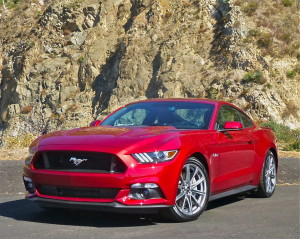
The 2015 Mustang has a lower, sleeker look covering all sorts of technical improvementsBy John Gilbert
By John Gilbert
The Ford Mustang takes the term “icon” to new dimensions. Amid very successful pickup trucks and various sedans and SUVs, the Mustang earns icon status by standing out as the very personality of Ford Motor Company. And for 2015, the Mustang takes its own image, as well as Ford’s, upward to new heights of styling, performance and technology.
The totally redone Mustang has an enormous responsibility, being the sixth generation of the car that first hit the streets of Dearborn in 1964. That’s a long time ago — 50 years ago, to be exact. And the new car seems to have reached all the high points befitting its 50th anniversary.
“Fast, fun and affordable,” is the way Mustang vehicle engineering manager Tom Barnes put it. I wasn’t sure if that was a new corporate motto or if Barnes was describing the combination of all the new Mustang’s attributes, but if it’s not the Mustang Motto, it should be. The Mustang will start in the mid-$20,000 range and run upward, depending on the restraint buyers show at the upgrade and option checklists.
Since its inception in 1964, the Mustang has grown bigger, then smaller, then almost disappeared, before being revived in the last decade as a retro model that brought everyone back to the heyday of its first and most classic years. For 2015 the evolution continues and the Mustang sets new standards as a sleeker, quicker and more maneuverable sporty coupe that is a little bit retro and a large bit contemporary, with a dose of Ford’s most futuristic EcoBoost technology.
Ford introduced its 2015 Mustang to auto media in Los Angeles, stressing it as a finished product more than simply for its improved power. But the two are intertwined impressively. Under that long and curvaceous hood you choose one of three engines. A surprising new EcoBoost 4-cylinder joins the returning V6 and the bolstered V8 in a versatile arsenal. All three engines reach or surpass 300 horsepower, yet promise economical operation through a pair of 6-speed transmissions, a Getrag manual, or the automatic, which has steering wheel paddles for a sporty touch on all applications.
The base engine is the 3.7-liter V6, with 300 horsepower and 280 foot-pounds of torque, while the top engine is the 5.0 V8, with its sophisticated chain-driven dual overhead camshaft design spinning to a whopping 435 horsepower and 400 foot-pounds of torque, with a top speed of 155 miles per hour. But the spotlight shines brightest on Ford’s newly redesigned EcoBoost 2.3-liter 4-cylinder, thoroughly upgraded and reinforced to handle the twin-scroll turbocharger’s force-fed demands. In the Mustang, it delivers 310 horsepower and an amazing 320 foot-pounds of torque. From a 4-cylinder.
“The new 2.3 has more horsepower than our V8 did 10 years ago,” said Barnes, pointing out the power is complemented by an advertised 32 miles per gallon.
“We had hundreds of people working on this Mustang for the last four years to make sure we had everything from the powertrain to the stiffer structure, to ride comfort, and to improve response and handling, as well as the appearance, inside and outside. We had a lot of input from people and a lot of debates and discussions, because we had to live up to the heritage of the car but also move forward.
“I think we absolutely nailed it.”
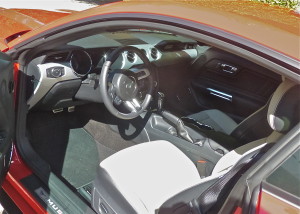
Interior choices are focused on driver’s command, and the base seats are supportive, if a cut below the GT’s Recaros.
Small engines that over-achieve always have been my preference, and the EcoBoost 2.3 proves that large displacement isn’t the only route to performance potency, while that potency and good real-world fuel-efficiency needn’t be mutually exclusive. German manufacturers such as Audi/Volkswagen, BMW and Mercedes all have 2.0 turbos as their primary base power, and the 2.3 EcoBoost proves that small-displacement, high-performing engines with great fuel economy isn’t an exclusive domain of the Germans.
When Ford first decided to go with the turbocharging technology it calls EcoBoost, it began with the 3.5-liter V6, built from the ground up to withstand the rigors of rapid surges of RPMs produced by turbocharging. The 2.3, meanwhile, first came to Ford with its smaller 2.0 brother from previous affiliate Mazda, when the two companies had some joint ventures. Refined through the years, they became known as the Duratec family of engines, with no connection to the smaller Sigma family that includes the 1.6, 1.3 and 1.0-liter units. Over the years, the Duratec as come a long way.
“The only thing this engine has in common with that original 2.3 is the placement of the cylinders and the displacement,” said Scott Makowski chief engine architect on the EcoBoost fours. “It’s pretty streamlined, with the turbocharger and direct injection mounted low, on the side, and the exhaust manifold integrated on the other side. It wasn’t cheap to do things like put a steel crank in it , but all along, we looked for anything we could do to strengthen the engine.”
That includes a die-cast (instead of sand-cast) block, and camshafts, a forged steel crankshaft, special piston rings and connecting rods, cooling jets on the aluminum pistons, and other modifications to reinforce the 2.3 for the rigors of being force-fed by the Honeywell-built turbocharger.
“We wanted 300 horsepower, and we got 310, with 320 foot-pounds of torque,” Machowski said. “We never chased horsepower at the expense of torque, and we never sacrificed gas mileage, horsepower or torque. We were able to get 240 horsepower out of it with a single-scroll turbo, with great power but no low-end. We went with the twin-scroll turbo because it has more pulses, which give faster response. Our emphasis was on getting the torque right because we knew the horsepower would come along later.
“The torque peak is 2,750 RPMs, but 90 percent of it comes in at only 1,750. The 310 horsepower means we got 137 horsepower per liter, which is one of the highest figures in the industry.”
The obvious competitors for the Mustang are the Chevrolet Camaro and the Dodge Challenger, both of which have just been reintroduced with huge power outputs. But all that power necessitates enormous pushrod engines — the. Camaro has an optional 7.0-liter V8, and the Challenger offers Hemi V8s of 6.2, 6.4 and a supercharged 6.2-liter with 707 horsepower. The price for those top-performing models is equally astronomical. That connects back to Ford’s “fast, fun, affordable” concept.
The V6 base car will start under $25,000 when it hits showrooms, and it will be the choice of many who love the style and substance and want to get a bargain first and foremost. The base price for the GT, with its neat-sounding 5.0-liter V8 reaches up to a $36,100, although you can find another $10,000 of options to add without difficulty. The 2.3 EcoBoost model steals the thunder again, however, with a starting price of $29,170, still armed with all the technical upgrades from the twin-scroll Honeywell turbocharger on up.
There are those who will demand a V8, just for tradition’s sake. Makowski, in fact, might have been one of them, until he proved himself perfectly suited to directing the new engine project, combining the new technology with an appreciation for Mustang heritage.
“I have an old V8 Mustang that I built,” said Makowski. “And while I like all three of these models, the 2.3 EcoBoost is my favorite. We haven’t chased horsepower at the expense of torque , and we haven’t chased power at the expense of fuel economy.”
New suspension at all four corners is highlighted by independent rear suspension, which replaces the solid-axle rear axle that has served the Mustang from the start. Engineers said that Ford considered both rear-end systems on the first Mustang, but chose the solid axle, and stuck with it. The improved steering, as well as the handling and power, must be driven to be appreciated. We proved it on our test runs up and down the San Gabriel Mountains east of L.A., driving the GT with its 5.0 V8 and the 6-speed stick on the way up, and then the 2.3 EcoBoost with the 6-speed automatic and its steering wheel paddle shift controls over similarly winding mountain roads on our return. We were impressed with both.
The GT’s V8 sound and punch is so good that I joked with Ford engineers that it essentially was a “1-speed” on those roads, because I was able to fly up around all the curviest mountain roads by simply leaving it in third gear. When approaching a tight curve, third could harness all the power sufficiently to slow the GT down entering the turn, yet lower-end torque was more than enough to pull us out of those curves with smoothly accelerating bursts, and letting it rev merely improved the sound.
I would also have liked to try the non-GT with the 2.3 EcoBoost and the stick shift, but in the available time, I also wanted to give the paddle-shifting automatic a strong try, so that’s what we chose. Shifting it manually and sailing around the similar curvy roads, the Mustang’s agility not only reflected the car’s improved weight distribution but, when we got to the bottom, its computer showed 31.4 miles per gallon. Imagine if I had driven it easy, rather than pushing it to handling limits.
A subtle element of fuel economy goes beyond miles-per-gallon figures. It is whether a car requires premium fuel, which often costs 30 or 40 cents more per gallon than regular, or whether it is merely recommended. Makowski didn’t make a big issue of it, but explained that the 2.3 EcoBoost was designed to run all day on 87 octane regular.
“We developed the 2.3 EcoBoost to run on 87 octane regular, all day,” he said. “You might get a little better horsepower with premium, but we made sure we met the minimum levels of performance on 87.”
That is just another plus for the Mustang-on-a-budget buyers. If you can blast it off the line once in awhile, and push it through turns or around cloverleafs, but have enough restraint to get 30 mpg, you can consider donating an extra $3 to $5 toward the car payment every time you fill the tank. And you could still fill up with premium every once in a while, such as for track day.
Most buyers may be unconcerned about the impressive technology that went into making the new Mustang world-class; they’ll be reeled in by the lure of the Mustang mystique and its great new look. That became clear when I was driving a gleaming white Mustang GT on a test drive, and I pulled into a strip mall parking area, not realizing I had been followed by an eager young fellow who parked and ran over to me.
“What kind of a car is this?” he asked, as I climbed out. I told him it was the new 2015 Mustang GT, and he couldn’t stop smiling and offering praise as he circled the car, gazing and shooting cell-phone photos every few steps.
Now, the 2015 Mustang has revised lines and a bit more sinister look compared to the current model, but it never occurred to me it looked like anything other than a Mustang. Nonetheless, spontaneous surveys are fascinating, and add evidence to the evaluation. For me, it confirmed that the new Mustang, with its lower and sleeker styling, balanced with the polished technology under the skin, is ready to go galloping off into an unbridled future.


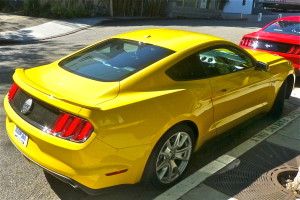
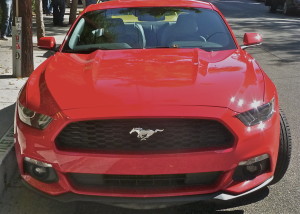
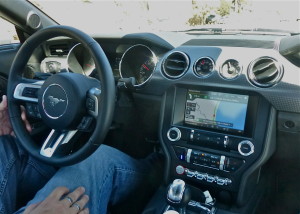
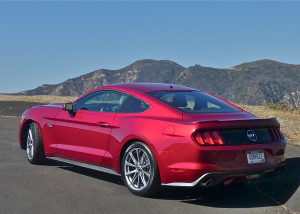
 John Gilbert is a lifetime Minnesotan and career journalist, specializing in cars and sports during and since spending 30 years at the Minneapolis Tribune, now the Star Tribune. More recently, he has continued translating the high-tech world of autos and sharing his passionate insights as a freelance writer/photographer/broadcaster. A member of the prestigious North American Car and Truck of the Year jury since 1993. John can be heard Monday-Friday from 9-11am on 610 KDAL(www.kdal610.com) on the "John Gilbert Show," and writes a column in the Duluth Reader.
John Gilbert is a lifetime Minnesotan and career journalist, specializing in cars and sports during and since spending 30 years at the Minneapolis Tribune, now the Star Tribune. More recently, he has continued translating the high-tech world of autos and sharing his passionate insights as a freelance writer/photographer/broadcaster. A member of the prestigious North American Car and Truck of the Year jury since 1993. John can be heard Monday-Friday from 9-11am on 610 KDAL(www.kdal610.com) on the "John Gilbert Show," and writes a column in the Duluth Reader.